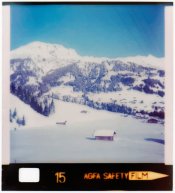Mike Briggs
Member
Hello
Can anyone identify the film in the attached image? Agfa, obviously, but with a square image and having single perforations. The film is 35mm high, 20 images to a roll, and dates from the 1970s.
It would be interesting to know the camera models that might have been able to shoot it too.
Thanks!
Can anyone identify the film in the attached image? Agfa, obviously, but with a square image and having single perforations. The film is 35mm high, 20 images to a roll, and dates from the 1970s.
It would be interesting to know the camera models that might have been able to shoot it too.
Thanks!
Attachments
Last edited by a moderator:












